It’s been a year since TheDetroitBureau.com reported first driving the innovative Chevrolet Volt, the first fully developed gas-electric plug-in hybrid. In the months since there has been a lot written about the Volt, its rivalry with the pure battery-electric Leaf and the slow market acceptance of battery vehicles. So, we thought, it might be time to go back and take another look to see if that initial, positive review still held.
In a few words, I liked it. A lot. It neatly solves the problem of range anxiety suffered by pure electrics. The Volt switches back-and-forth effortlessly from stored electric juice to its 1.4-liter
Austrian-made gasoline engine. Altogether, it is a very pleasant, quiet, easily handling, smooth performing and riding car.
The biggest problem I could discern was the nameplate. At a sticker price of nearly $44,000 as delivered from GM’s media test fleet and quipped with premium options of navigation system and sunroof—but before the federal tax credits — General Motors should have branded it a Cadillac.
Normally, new car buyers would not consider entering a Chevrolet dealership to cough up that kind of money, whereas they’d expect it at a Cadillac store. Still, whatever the brand name, this kind of car does not attract normal buyers, as witness the Toyota’s experience with the Prius. People don’t buy hybrids and electrics to save money on fuel costs. They do it because they like new, high-tech toys, because they want to help the environment, because they want to stick a thumb in the eye of Middle East (or Texas) oil barons, or just because they’re show-offs.
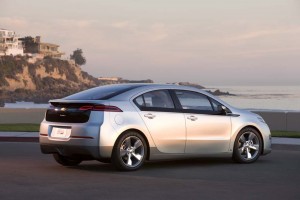
The basic platform is shared with the Chevy Cruze but there are significant tweaks, including Volt's hatchback configuration.
Over the last decade, I’ve had the opportunity to drive GM’s EV-1 “pure” electric like those leased to customers in Californian and Arizona, an experimental battery-powered Ford Ranger, a second-generation 2003 Toyota Prius hybrid and a same vintage Honda Civic hybrid. Funny thing is, other auto writers rarely seemed to mention these vehicles’ most outstanding attribute: absolutely quiet operation.
Indeed they are so silent that Federal auto safety watchdogs have suggested electrics and hybrids must be noisier so as to protect unwary pedestrians and cyclers. Thus the Volt includes a cartoon road-runner-like “beep-beep” horn at the tip of the lamps stalk. This reminds me of 1939 Chevrolets, which offered optional, toggle- switch-operated “city” horns with lower noise-output than regular “country” horns.
This horn feature is just one example of how completely developed the Voltage is. Every detail of the car seems exceptionally well-thought- out and executed, unlike some other contemporary GM and competitive cars which, no matter how advanced in concept, still seem to suffer from annoying execution flaws.
When the Volt was delivered to my driveway for a week’s test drive, it had consumed about nine of the +/- 40 miles of battery-driving available. Immediately I had to depart for a meeting in midtown Detroit some 11 miles distant. By the time I got home, the operating battery was close to needing a charge: the instrument cluster readout promised a range of 321 miles, 309 from the gas engine but just 12 from the battery. Thus arose an opportunity to try the Volt’s notable plug-in feature.
Circumstances compelled me to undertake this experiment outdoors at night in pouring-down rain, what one might call an acid test. With no opportunity to study the Owner Manual, I “fearlessly” fetched the charging package from under the hatchback floor, unwound its three-prong “Out” and unfamiliar “In” cords, and proceeded to plug the Out into a regular household 110-Volt wall outlet just inside my garage door. I’d already flipped the switch in the driver’s door to open the fuel-filler-like panel over the plug-in socket, located hip-high in the front left fender forward of the driver door. To my surprise, I found the In cord had a squeeze-handle like the safety grip on a Model 1911 A1 .45 pistol, illuminating a light at the end of the cord so that I could see how to plug it into the car’s receptacle in the pitch dark. It all worked seamlessly.
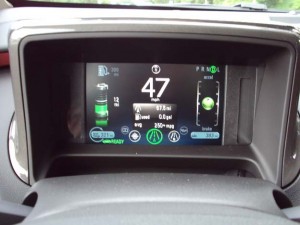
The all-important LCD screen reveals the mode the Volt is operating in and how much range you have on electric or gas power.
The next morning, after 12-13 hours being plugged in, I found the Volt fully charged, promising 40 miles on juice, and headed off for another meeting on the other side of metro Detroit. This time, on my way home, I noticed a low engine noise hum just as I turned onto a freeway, indicating the juice had all been drawn down and the small gas engine had kicked in. Normally, it is supposed to take 10 hours to fully recharge the operating battery on a 110-volt line but only 3.5 hours on 240V.
By the time I got home, though, the operating battery—a huge T-shaped mass under the cabin floor between the seats (preventing a center rear seat)—had recharged itself somewhat due to coasting and braking
At this point, the instrument panel read-outs were telling me I had a puzzling choice of three different miles-per-gallon rates: 64, 91 and “lifetime” 110. By the time I had to give the car back, the well-executed instruments also told me that in 120 miles of “city-suburban” operation, the Volt had used 1.42 gallons of 91-octane (premium) gasoline from the 9.3 gallon tank and 10.2 kilowatts of electricity.
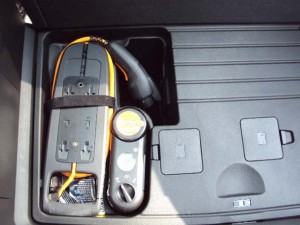
A built-in 220 V Level II charger is preferred, but Volt comes with a portable 110-v charger tucked under the cargo floor.
According to my last five electric bills, not covering the period of the Volt recharge, my kilowatt rate appears to average 14.6 cents; 91- octane gas as I write this is priced locally about $3.60 per. The arithmetic then suggests recharging boosted my electric bill by $1.49, plus topping the gas tank would have cost $5.11, for a total “fuel” cost of $6.60. A regular domestic car rated at 30 mpg would have taken four gallons of 87-octane regular at say, $3.40 each for a cost of $13.60.
So, yes, the Plug-in Volt is less expensive to operate—as long as you don’t include amortization of the capital cost versus, say, that for a well-equipped “normal” sedan half to two-thirds the sticker price. But the Volt only carries four occupants, versus five for most other sedans; thus if you counted the mileage costs on a per occupant, fully occupied basis, the Volt advantage would shrink proportionately.
The Volt Owner Manual plus an instructional read-out choice on the center stack instrument panel suggest extending juice range by minimizing use of electric-power-using options like the heater/defroster/air conditioning fan (but electric seats are OK—evidently powered by the storage battery mounted under the luggage compartment in the rear).
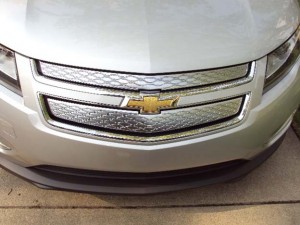
Aerodynamics are critical to the Chevy Volt, designers sealing off the grille to reduce wind drag - and improve battery range.
As noted earlier in this report, though, people don’t buy cars like the Volt to save money on operating costs, because you’d have to drive it forever to recover the initial cost—unless you had a Cadillac in mind in the first place, in which case, the Volt is a very nice Cadillac.
Though I believe the Volt is flawlessly conceived and executed, I did note a couple of off-puts. One, in order to minimize the drag effect of air flow, the car is lowered below normal standards plus it has an even lower front air dam; the result is the likelihood of scraping that air dam on the pavement in ordinary driving. Second, despite a huge glass backlite in the hatch, the Volt lacks a rear wiper. In some parts of the country, this won’t matter, but in the snow belt it matters a lot. Third, like a lot of other new models these days, there is no spare tire (saves weight and cost), but there is a neatly packaged pressure gage, sealer and pump to provide limp-home capability.
Bottom line: if I were in the market for a $40,000 four-place sedan, Volt would be at the top of my list. It is both a joy to drive and a technological wonder to appreciate.
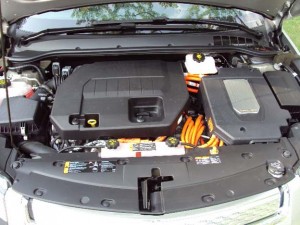
There's a lot tucked under the hood of the Volt - though the 450-pound battery pack is hidden in the center hump and under the rear seats.
When Chevrolet first announced the Volt a little over a year ago with much fanfare, the foolish new GM CEO imported from Wall Street told the media he expected production to amount to 40,000 the first year. Ever since then, said media have been dogging GM to come up to that mark, an expectation that apparently was not in any realistic planning.
Through the end of September, Volt retail sales in the US have totaled 3,895 (only 723 in September proper), obviously far short of a 40k hope. Critics have beat up on GM for this number versus, say, Nissan’s plug-in pure electric Leaf, with sales for nine months 2011 of 7,199, including 1,031 in September.
However, Chevrolet PR tells The Detroit Bureau that all is rolling out according to plan. Up until now, Volts have been sold in only the District of Columbia and six states: California, Texas, Michigan, New York, Connecticut and New Jersey. Volt sales will be extended nationwide by the end of the year.

The size of the battery pack required Chevy to go with a 4-seat layout for Volt - but the hatchback has plenty of cargo space.
Thus the output is scheduled to total only about 16,000 Volts the first year, 10,000 for retail sale in the U.S., plus 2,600 to be demonstrators for each domestic Chevy dealer and another 3,500 tagged for export to Canada, Europe and China. This volume is not inconsistent with the 15,000 or so SSR pickup roadsters Chevy– a vehicle also priced in the $40s–produced annually at a Lansing facility, 2003-2006.
Further, while production has been ramped up at GM’s Hamtramck Assembly Plant (the infamous Poletown Plant once only for Cadillacs) it is still modest, about 150 per day on a 40-hour weekly schedule; the plant also is now assembling Chevrolet Malibu and produced Cadillac CTS and Buick Lucerne as well as Volt before the July changeover.
Parting thought: is the $7,500 Federal juicer rebate also IRS taxable income? Ouch!

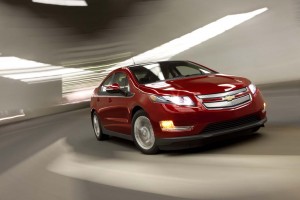

Thank you for all of the detail in this article.
A few points that I hope that you find useful:
1. The nameplate (“Chevy”) makes sense because the car is a “halo car”. Perhaps some of the success of the sales of the Cruze may be due to the Volt.
Despite demand that exceeds supply, Chevy has required that Dealers keep demonstration models for 6 months. The effect is that shoppers come in to take a look at the Volt and perhaps walk out with a Cruze or Malibu.
2. The vehicle does not come with a Sunroof. It is too heavy and would have too much drag if opened. Perhaps you were thinking of a different option?
3. In Michigan, many people are eligible to get the 220V charger with special DTE rates. They offer two choices both of which would be more favorably than your short term experience.
– As long as you charge at night and on the weekends (which can be programmed by your iPhone or the car itself), you would pay 8cents/kWh… – – They also offer a flat rate of $40/month ($1.33/day), unlimited. With this plan, you can charge 2x per day if you need to.
4. Perhaps I am in the minority, but I bought the car to save money on operating costs. The math is not too hard to justify.
I replaced a 2008 Impala. I estimate that the new version of the Impala that is comparably equipped to the Volt that I leased, would be $340/month ($0 down, 15,000 miles per year).
My Volt lease rate is $500/month. However, I expect to exceed $160 in fuel costs (even when factoring in electricity).
The net effect for me is that I get to upgrade from an Impala to a Volt with no increase. I simply pay more to US Bank (the leasing company) and less to Exxon, Shell or BP.
NOTE that the $7500 goes to the leasing company (not me). However, it serves to reduce the downpayment. There is NO Tax implication to me. I simply enjoy the benefit of getting the car for the same monthly rate as an Impala.
Seems to me that if the $7500 is taxable income, than so is mortgage interest credit that most homeowners get. My understanding is that you cannot both receive a credit and then get socked as income on your tax return.
5. I am not sure where you saw the quote from GM indicating 40K in the first year. Perhaps misunderstanding “first full year that it is nationally available”?
The projections that I have seen for a while have been 15K year 1, then 40-60K in year 2 (including exports). Since the car has only been for sale in 6 states until very recently, it would be impossible to sell 40K in year one even if the demand was through the roof.
Hi, Bobblehead,
I will ask Mike Davis to respond to your points. One that I will weigh in is that the issue of nighttime charging is a bit of a red herring. I don’t disagree that it is cheaper…and I also expect EARLY adopters to generally do just that. But as battery vehicles, in general, go mainstream that is likely to become less common despite all the claims of the auto and power industries. In fact, I found several senior GM officials agreeing with my contention during last week’s Chevy news conference and subsequent discussions (during which the news of the Spark EV, for one thing, was revealed). To go mainstream buyers will likely appreciate the ability to charge at a reduced rate at home once they do call it a night but will also expect to be able to charge up whenever convenient during the day, as well, and often at Level III stations. The challenge there, as I have often noted, is a very lousy U.S. electric grid.
Meanwhile, let’s have Mike weigh in.
Paul A. Eisenstein
Publisher, TheDetroitBureau.com
Thanks very much for your knowledgeable and fact-filled commentary on my Volt article. I wish ESP were such that we had communicated before I wrote it!
You’re correct about the sunroof. Don’t know how that got into my write-up, because the nearly $3,900 in options on the test car included only $1,995 for the Audio/Navigation system, $1,395 for Premium Trim package (heated seats & leather) and $495 for a Bose speaker system. Sorry about that!
Glad you clarified the tax issue, and I hope you are right. If the rebate gets knocked off up front, than the buyer would have no liability. But I don’t trust the IRS not to go looking for any additional revenue they can scam–that’s their job.
I haven’t had an opportunity to drive an Impala in recent years, but I commend you, Pioneer, for a wise product choice for the replacement Volt. The Volt’s had a lot of Gee Whiz commentary in the media, but I think little judging it simply as a very satisfactory set of wheels.
Regardless of charging times and costs, the main point is that the Volt eliminates “range anxiety,” which can’t be said for the pure electrics, plug-in or not.
I’ll get to that issue when I have a chance to drive the Leaf for several days in a couple of weeks.
Great stuff! Thank you.
1. I did have a typo in my original comment. The quote: “However, I expect to exceed $160 in fuel costs (even when factoring in electricity).”… should read: “However, I expect to exceed $160 in fuel SAVINGS (even when factoring in electricity).”
2. A am confident about the tax incentive. However, you may want to contact GM or another authority to triple check.
The tax incentive points to why the lease is better than the buy on this car right now. By leasing, you do not need to wait until tax time to get the benefit. In addition, you do not need to worry about how long the battery will last or if a new technology will eclipse the current one.
3. Though there are a few electric vehicles on the road, I am surprised by how many chargers are installed. Of interest to me there are chargers at all of the following locations:
– Downtown Ann Arbor
– At Washentaw Community College
– At Schoolcraft college in Livonia
– At the Compuware building downtown Detroit (very handy getting out of the parking lot from the first floor during a recent Tigers playoff game).
– In front of Haworth Inn (Hope College) where we vacation in Holland, MI.
Because I had the Coloumb charger installed, I have access to all of these chargers for FREE. The downside is that I have to allow them to collect data on my charging habits. Not a bad trade-off to me.
As your review the Leaf, you may want to take a look at this site to get a better understanding of the chargers that are available:
http://mychargepoint.net/
Hi, Bobble,
I’ll focus on the charging issue, which is specifically the topic I responded to yesterday, and leave the rest for Mike. It’s nice to see Level II chargers in public locations. Now, imagine that we had the equivalent for gasoline vehicles. First, you’d have to hold no more than 3 gallons of gas to start with (assuming equivalent range)…and then you’d be only able to fill at a rate of a bit more than 1 gallon/hour. That’s assuming a reasonably fast Level II. This is great when there are a couple, maybe even a half-dozen chargers at any location, you’re spending many hours at school, work or a game and…most significantly…there are only a handful of battery cars on the road, most driven locally by people that appreciate and accept the sacrifice. Now, however, let’s look ahead to 2015 (or beyond) when, if Pres. Obama is on target, we have 1.5 mil battery cars in use and suddenly, you have 50, 75, 100 lining up for those chargers. I could continue with the scenario. To do this right we need masses of the most advanced Level III chargers becoming steadily more common to the point of eventually becoming as ubiquitous as service stations. This would be less critical with a mix favoring plug-ins/range-extenders, of course. But the more common battery cars get the more the support infrastructure will have to resemble — and operate like — the current gas station network.
Oh, and having my power briefly drop out, a few moments ago, I am yet again reminded of the problems with the grid itself that would need to support the charging network.
Paul E.